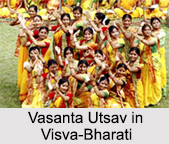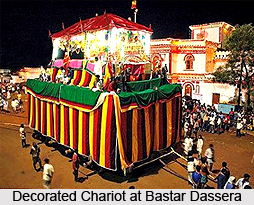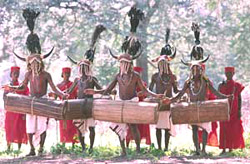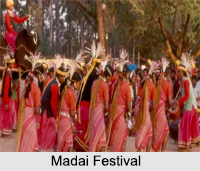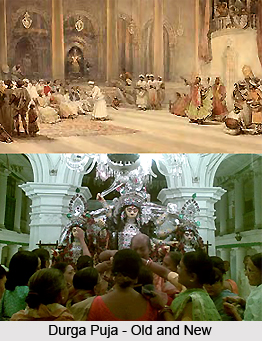 Rituals of Durga Puja start from the day of Mahalaya and continue till Dashami. The rituals include Bodhon, Amantron, mangal ghat, bathing of Nabapatrika and so on. Sacrifices are also included in the rituals. Earlier there was animal and human sacrifice. Since the rule of Vaishnava Kings there has been no such sacrifice. Vegetables are sacrificed instead. The sacrifice of pumpkin was one of the most common substitutes. Sacrifice is basically casting away of one`s sins and faults.
Rituals of Durga Puja start from the day of Mahalaya and continue till Dashami. The rituals include Bodhon, Amantron, mangal ghat, bathing of Nabapatrika and so on. Sacrifices are also included in the rituals. Earlier there was animal and human sacrifice. Since the rule of Vaishnava Kings there has been no such sacrifice. Vegetables are sacrificed instead. The sacrifice of pumpkin was one of the most common substitutes. Sacrifice is basically casting away of one`s sins and faults.
Incantations
Mantra has the power to accomplish what they say in the context of the Puja. Chanting of Mantras in a Puja is very efficacious. The power of mantra is associated with Puja and kriya. One can take refuge in God as Mother.
One finds the following prayer to Mother Durga in the Mahanarayana Upanishad (2.2): I take refuge in Her, the Goddess Durga, who is fiery in lustre and radiant with ardency, who is the Power belonging to the Supreme, who manifests Himself manifold, who is the Power residing in actions and their fruits, rendering them efficacious (or the Power that is supplicated to by the devotees for the fruition of their work). O Thou Goddess skilled in saving, Thou takest us across difficulties excellently well- Our salutations to Thee.". She is duly worshipped in both aspects. One hymn praises Her benign Power, saying, "To Durga, the gracious and ever-benign, to the ever-auspicious One, the manifesto of all the worlds, I offer my respectful obeisance." With words of humility and reverence, another hymn praises both aspects: "Obeisance to Thee, O Divine Mother, Durga, the benignant and yet terrific roaring. Thou art power, the dark night of destruction." Both aspects, understood correctly, reveal Her benign redeeming grace. She destroys but to save. The vibrations give power. It is the sound that produces vibration. Mantra has the quality of a spell. People generally accept the action of the mantra when it is uttered by an ascetic. Mantras need to be pronounced correctly. Mantras contain the deity`s name in a particular object in which it is invoked.
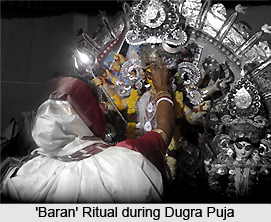
Gestures
Mudras are efficacious gestures which has a similar nature to that of the mantras. Mudra is a hand shown gesture of the priest. There are several mudras which are particular to Durga Puja. Mudras act in combination with mantras. Mudra brings about what it represents. The first ritual is the abahan mudra followed by sthapan Mudra. Sthapan Mudra indicates the entry of a deity. Sangbodhani mudra is made by the two fists which are placed side by side and the fingers are curled under the thumbs. Again sammukhi mudra is formed by the two fists and the thumbs are held up. In the preliminary stages of a Puja these mudras occur. These mudras recur throughout the Puja.
Bodhon and Amantron
Bodhon and Amantron are the welcoming rituals in this festival. Welcome and reception of the goddess are the rites of Belbaran, Kalparambha and sankalpa. All welcoming rites include a sankalpa. The ritual of Bodhon is the awakening of the goddess. The Hymn to the Divine Mother in The Devi Mahatmyam (Chandi XI: 10-12) says, sristhi sthitivina shanam, "(Thou art) creation, preservation and dissolution," and paritrana parayane sarvasyarti hare devi, (Thou art) the remover of misery of all, full of eagerness to save." The Divine Mother gently guides Her children to attain moksha, which Shri Ramakrishna says is Her Power of Vidya-maya.
Amantron is an act of greeting performed for deities alone.
Ghat celebration
After belbaran, the bathing of the Nabapatrika is done at the Ghat. The Puja is performed after this. Eight small jars are used in the rite along with a single larger one with a hole in its bottom. The eight jars represent the eight holy waters and rivers, the ninth representing the waters of the holy land of India.
The goddess is bathed in the Ganga River which is termed as Mahasnan. In these rites goddess is symbolized in different ways.
The prime time of the Puja is the `Sandhikshan,` which is the crossover time between Ashtami and Navami. Everyday in the morning Arati takes place. On Dashami the image is immersed in a pond or river. Sweets are exchanged between families and this ritual is called `Bijoya`.

